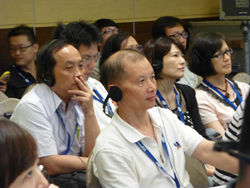
Bangabandhu Sheikh Mujib Medical University (BSMMU) is the only medical university in Bangladesh. It is also the leading post-graduate medical institute in the country. It has a supreme role in raising the quality of medical study and research. BSMMU is one of the largest beneficiaries of the Academic Innovation Fund (AIF) under the Higher Education Quality Enhancement Project (HEQEP) which has brought about significant improvements in the quality of medical education and research.
The university is now launching the first-ever virtual classroom for medical education in Bangladesh. The World Bank blog cited a story in this regard.
Teaching quality in medical education and training is increasingly a troublesome issue in Bangladesh. Teachers in medical colleges are inadequate both in quantity and quality. Currently there are only around 120 pharmacology teachers across 86 medical colleges in Bangladesh.
To address the challenge, the AIF supported the Department of Pharmacology of BSMMU to establish the first-ever virtual classroom system for medical college students in Bangladesh. The system has a great potential of changing the landscape of medical education and training in Bangladesh.
The “Virtual Teaching-Learning Program on Pharmacology” sub-project was launched to pilot innovative use of information technology in medical education by establishing a virtual classroom environment. Under the pilot, medical college institutions across Bangladesh are connected to the virtual classroom. It allows senior medical professors in Dhaka and even international experts from abroad to deliver their lectures to students in medical colleges in different regions. Students can attend real-time online classes, download teaching materials, and assess their competence in self-administered test.
“So far 36 topics are available to the students for free. An online question bank has been uploaded containing about 4,000 questions. We also established a synchronous teaching system that is so far connected with 32 medical colleges. Professors in Dhaka now remotely teach classes to students outside of Dhaka, and sometimes international guest lecturers also give lectures via the synchronous system. It is an exceptional experience for students in remote areas to listen and ask questions to renowned medical professionals. The bandwidth of internet connectivity is the only challenge. BSMMU is connected to high-speed Bangladesh Research and Education Network (BdREN), whereas colleges in remote areas have only narrow-band connectivity and cannot receive our synchronous broadcasting. It is now essential for the colleges to get broad-band internet connectivity.” says Professor Mir Misbahuddin, the sub-project manager at Department of Pharmacology, BSMMU.
Establishing a world-class genetic research environment
The “Modernization of Genetic Research Facilities and Patient Care Services” sub-project by the Faculty of Basic Medical Sciences is another success at the BSMMU. The sub-project installed a Next Generation DNA Sequencer, the only one of its kind in the country, and established a modern fully equipped genetic research laboratory. The sub-project aims to promote research on human genetic diseases in Bangladesh, which have never been addressed due to the lack of proper facilities, and invites international experts in genetics and molecular biology to train medical researchers in Bangladesh.
“With this Next Generation Sequencer, we can now analyze the DNA sequence of Bangladeshi citizens and explore the genetic data of most prevalent genetic diseases in Bangladesh.’ explains Dr. Laila Anjuman Banu, sub-project manager and professor of Genetics & Molecular Biology. “Currently, we are developing a database of patients suffering from breast cancer and hypertrophic cardiomyopathy in Bangladesh. The database is useful for researchers in Bangladesh for further researches on developing molecular diagnostics and designing targeted therapeutics in the near future. This is a cutting-edge arena for medical research worldwide. We have published two papers already using this new sequencer.” she added.
AIF sub-projects awarded to other departments such as Anatomy, Urology, and Palliative Care have been equally successful
source: newshour.com.bd



 The politics of establishing a second medical school shouldn’t impede efforts to ramp up medical education in Spokane this year. The University of Washington and Washington State University both agree that many more students are needed. The state can’t wait.
The politics of establishing a second medical school shouldn’t impede efforts to ramp up medical education in Spokane this year. The University of Washington and Washington State University both agree that many more students are needed. The state can’t wait. Innovaacom, a leading provider of medical education and training for healthcare professionals worldwide, today announced it is expanding its services into Asia in 2015. Innovaacom’s focus on innovative solutions for this area of the world comes at a time when Asia’s strengthening economy and leadership are rallying around consumer demand for better healthcare. A rapidly growing aging population and changing socio-economic environment is driving healthcare system improvements and advances in medicine in Asia. “We are excited to be a part of the reinvention of healthcare and renaissance of high science and emerging medicine in Asia,” said Innovaacom CEO Ornella Vincenzino.
Innovaacom, a leading provider of medical education and training for healthcare professionals worldwide, today announced it is expanding its services into Asia in 2015. Innovaacom’s focus on innovative solutions for this area of the world comes at a time when Asia’s strengthening economy and leadership are rallying around consumer demand for better healthcare. A rapidly growing aging population and changing socio-economic environment is driving healthcare system improvements and advances in medicine in Asia. “We are excited to be a part of the reinvention of healthcare and renaissance of high science and emerging medicine in Asia,” said Innovaacom CEO Ornella Vincenzino.